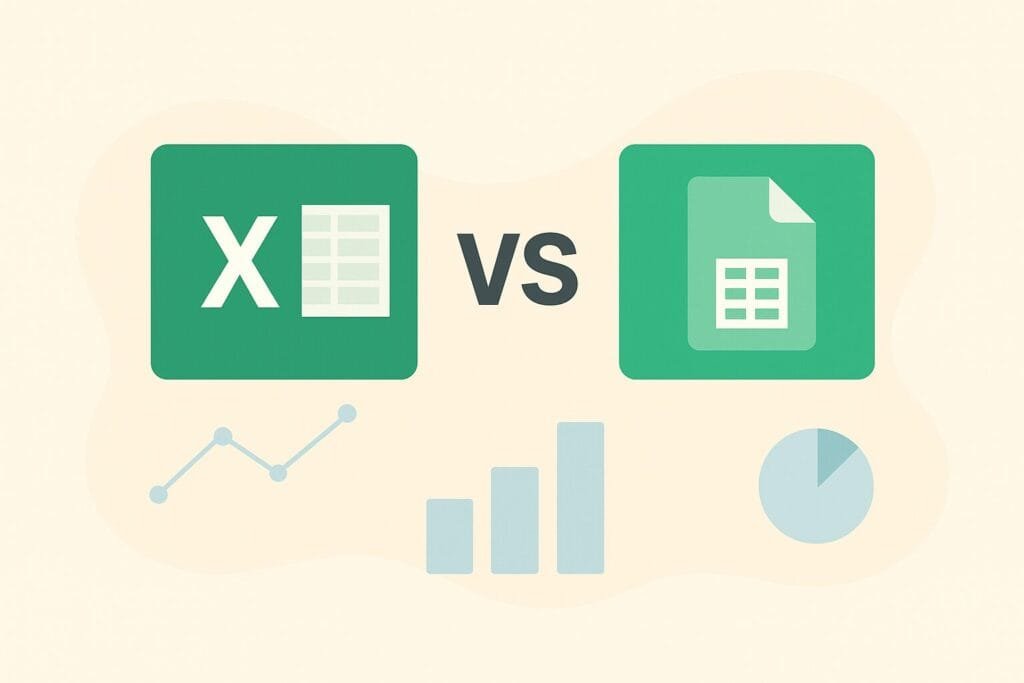When it comes to business analytics, two spreadsheet tools dominate the scene — Microsoft Excel and Google Sheets. Both platforms are essential for data analysis, reporting, and visualization. But when it comes to modern business needs — especially collaboration, automation, and scalability — which one is truly the best choice?
This article explores the strengths and weaknesses of each tool, comparing Excel vs Google Sheets for business analytics in terms of performance, features, collaboration, and pricing. By the end, you’ll have a clear idea of which one fits your organization’s data strategy.

1. Overview of Excel and Google Sheets
Microsoft Excel has been the gold standard for data manipulation for decades. Its advanced formulas, pivot tables, and macros make it a powerful choice for analysts and accountants. Excel offers deep offline functionality and integrates well with the broader Microsoft Office ecosystem.
Google Sheets, on the other hand, represents the modern era of cloud computing. Built for collaboration, Sheets allows multiple users to work simultaneously on the same file from anywhere. Its real-time updates and cloud storage make it an ideal tool for teams that prioritize accessibility and shared workflows.
2. Key Differences Between Excel and Google Sheets
| Feature | Microsoft Excel | Google Sheets |
|---|---|---|
| Data Capacity | Handles up to 1 million rows per sheet; suitable for large datasets. | Limited to 10 million cells; may slow with large datasets. |
| Collaboration | File sharing via OneDrive or email; limited real-time collaboration. | Excellent real-time collaboration with multiple users. |
| Offline Access | Fully functional offline with desktop version. | Offline access available via browser extensions, but limited. |
| Automation | Advanced automation via VBA (Visual Basic for Applications). | Automation through Google Apps Script (JavaScript-based). |
| Visualization | Rich charts, graphs, and Power BI integration. | Basic charting tools; integrates with Google Data Studio. |
| Security | Robust enterprise-grade security via Microsoft 365. | Cloud-based security with Google Workspace controls. |
| Pricing | Included with Microsoft 365 subscription. | Free with Google account; paid options via Google Workspace. |
3. Excel for Business Analytics
Microsoft Excel remains one of the most powerful analytics tools available. It supports complex formulas, data modeling, and automation with VBA macros. Many organizations use Excel for advanced financial modeling, forecasting, and performance dashboards.
Advantages of Excel for Business Analytics:
- Handles large datasets efficiently.
- Advanced formula and statistical functions.
- Integration with Power BI for visualization and reporting.
- Supports advanced add-ins and automation via VBA.
Limitations:
- Limited real-time collaboration features.
- File versioning issues with shared spreadsheets.
- Requires manual syncing when working across teams.
4. Google Sheets for Business Analytics
Google Sheets has become a favorite among startups, SMEs, and remote teams. It’s cloud-native, easy to use, and supports collaboration at scale. With Google Apps Script, businesses can automate tasks such as data import, reporting, and visualization.
Advantages of Google Sheets:
- Real-time collaboration across teams and departments.
- Integration with Google Workspace and cloud services.
- Simple automation using Google Apps Script.
- Ideal for lightweight data analysis and dashboards.
Limitations:
- Performance drops with large datasets.
- Limited built-in statistical and engineering functions compared to Excel.
- Dependent on internet connectivity for full functionality.
5. Performance and Scalability
Excel outperforms Google Sheets when handling large or complex datasets. Enterprises dealing with millions of records or running macro-based workflows will benefit from Excel’s robustness and offline performance. Google Sheets, while suitable for smaller datasets, may experience lag as data volume grows.
However, for modern collaborative workflows, Google Sheets has the upper hand. Multiple users can analyze and edit data simultaneously, making it ideal for teams that prioritize speed and transparency over computational depth.
6. Automation and Integration
Excel uses VBA for automation, which allows users to build powerful scripts and macros. It integrates seamlessly with Power BI, Microsoft Access, and SQL databases — ideal for data analysts and financial teams.
Google Sheets uses Apps Script, a JavaScript-based automation platform. It connects well with Google Analytics, BigQuery, and Google Data Studio, making it great for cloud-based data workflows.
7. Which Tool Should You Choose?
The decision depends on your business needs:
- Choose Excel if you need to handle large datasets, use complex formulas, or integrate with enterprise data systems like Power BI or SQL Server.
- Choose Google Sheets if you prioritize collaboration, remote work, and cloud integration for real-time analytics.
8. Final Verdict
In summary, Excel is the superior choice for data-heavy analytics and advanced modeling, while Google Sheets excels in collaborative, cloud-based environments. For many businesses, a hybrid approach — using both tools where they shine — delivers the best of both worlds.
As data-driven decision-making continues to evolve, understanding each platform’s strengths will help you create more efficient, scalable, and collaborative analytics workflows.
Conclusion
Both Excel and Google Sheets are valuable assets in business analytics. The right choice depends on your company’s workflow, data complexity, and collaboration needs. For power users and large-scale modeling, Excel remains unbeatable. For teamwork and flexibility, Google Sheets takes the lead.
Ultimately, integrating both tools strategically could empower your business with greater control, insights, and speed in decision-making.

